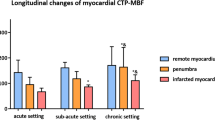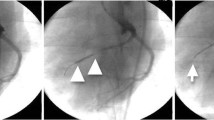Abstract
Purpose
Incomplete microvascular reperfusion is often observed in patients undergoing thrombolytic therapy or angioplasty for acute myocardial infarction and has important prognostic implications. We compared the myocardial uptake of diffusible (201Tl) and deposited (99mTcN-NOET) perfusion imaging agents in the setting of experimental infarction.
Methods
Rats were subjected to permanent coronary occlusion (OCC, n=10) or to 45-min occlusion and reperfusion (REP, n=17). Seven days later, the tracers were co-injected and the animals were euthanised 15 min (all ten rats in the OCC group and 12 rats in the REP group) or 120 min (five rats from the REP group, euthanised at this time point to evaluate any redistribution of the tracers: REP-RED group) afterwards. Infarct size determination and 99mTcN-NOET/201Tl ex vivo imaging were performed. Regional flow and tissue oedema were quantified using radioactive microspheres and 99mTc-DTPA, respectively.
Results
99mTcN-NOET and 201Tl defect magnitudes were similar in OCC animals (0.11±0.01 vs 0.13±0.01). In REP animals, 201Tl defect magnitude (0.25±0.02) was significantly lower than the magnitude of 99mTcN-NOET and flow defects (0.14±0.03 and 0.17±0.01, respectively; p<0.05), despite the lack of 201Tl redistribution (REP-RED animals). 99mTc-DTPA indicated the presence of oedema in the reperfused area. Blood distribution studies showed that, unlike 99mTcN-NOET, 201Tl plasma activity was mostly unbound to plasma proteins.
Conclusion
99mTcN-NOET and 201Tl delineated the non-viable area in chronic non-reperfused and reperfused myocardial infarction. The significantly decreased 201Tl defect in reperfused infarction was likely due to partial diffusion of the tracer from the plasma into the oedema present in the infarcted area. Deposited perfusion tracers might be better suited than diffusible agents for the assessment of regional flow following reperfusion of myocardial infarction.





Similar content being viewed by others
References
Ambrosio G, Weisman HF, Mannisi JA, Becker LC. Progressive impairment of regional myocardial perfusion after initial restoration of postischemic blood flow. Circulation 1989;80:1846-61.
Kloner RA, Ganote CE, Jennings RB. The “no-reflow” phenomenon after temporary coronary occlusion in the dog. J Clin Invest 1974;54:1486–508.
Matsumura K, Jeremy RW, Schaper J, Becker LC. Progression of myocardial necrosis during reperfusion of ischemic myocardium. Circulation 1998;97:795–804.
Reffelmann T, Hale SL, Dow JS, Kloner RA. No-reflow phenomenon persists long-term after ischemia/reperfusion in the rat and predicts infarct expansion. Circulation 2003;108:2911–7.
Rochitte CE, Lima JA, Bluemke DA, Reeder SB, McVeigh ER, Furuta T, et al. Magnitude and time course of microvascular obstruction and tissue injury after acute myocardial infarction. Circulation 1998;98:1006–14.
Ito H, Maruyama A, Iwakura K, Takiuchi S, Masuyama T, Hori M, et al. Clinical implications of the ‘no reflow' phenomenon. A predictor of complications and left ventricular remodeling in reperfused anterior wall myocardial infarction. Circulation 1996;93:223–8.
Baks T, van Geuns RJ, Biagini E, Wielopolski P, Mollet NR, Cademartiri F, et al. Effects of primary angioplasty for acute myocardial infarction on early and late infarct size and left ventricular wall characteristics. J Am Coll Cardiol 2006;47:40–4.
Wu KC, Zerhouni EA, Judd RM, Lugo-Olivieri CH, Barouch LA, Schulman SP, et al. Prognostic significance of microvascular obstruction by magnetic resonance imaging in patients with acute myocardial infarction. Circulation 1998;97:765–72.
Beller GA. First annual Mario S. Verani, MD, Memorial Lecture: clinical value of myocardial perfusion imaging in coronary artery disease. J Nucl Cardiol 2003;10:529–42.
Lund GK, Stork A, Saeed M, Bansmann MP, Gerken JH, Muller V, et al. Acute myocardial infarction: evaluation with first-pass enhancement and delayed enhancement MR imaging compared with 201Tl SPECT imaging. Radiology 2004;232:49–57.
Ammann P, Naegeli B, Rickli H, Buchholz S, Mury R, Schuiki E, et al. Characteristics of patients with abnormal stress technetium Tc 99 m sestamibi SPECT studies without significant coronary artery diameter stenoses. Clin Cardiol 2003;26:521–4.
Fagret D, Marie PY, Brunotte F, Giganti M, Le Guludec D, Bertrand A, et al. Myocardial perfusion imaging with technetium-99m-Tc-NOET: comparison with thallium-201 and coronary angiography. J Nucl Med 1995;36:936–43.
Ghezzi C, Fagret D, Arvieux CC, Mathieu JP, Bontron R, Pasqualini R, et al. Myocardial kinetics of TcN-NOET: a neutral lipophilic complex tracer of regional myocardial blood flow. J Nucl Med 1995;36:1069–77.
Pasqualini R, Duatti A, Bellande E, Comazzi V, Brucato V, Hoffschir D, et al. Bis(dithicarbamato) nitrido technetium-99m radiopharmaceuticals: a class of neutral myocardial imaging agents. J Nucl Med 1994;35:334–41.
Vanzetto G, Fagret D, Pasqualini R, Mathieu JP, Chossat F, Machecourt J. Biodistribution, dosimetry, and safety of myocardial perfusion imaging agent 99mTcN-NOET in healthy volunteers. J Nucl Med 2000;41:141–8.
Johnson G 3rd, Allton IL, Nguyen KN, Lauinger JM, Beju D, Pasqualini R, et al. Clearance of 99mTcN-NOET in normal, ischemic-reperfused and membrane-disrupted rat myocardium. J Nucl Cardiol 1996;3:42–54.
Johnson G, Nguyen KN, Pasqualini R, Okada RD. Interaction of technetium-99m-N-NOET with blood elements: potential mechanism of myocardial redistribution. J Nucl Med 1997;38:138–43.
Riou L, Ghezzi C, Mouton O, Mathieu JP, Pasqualini R, Comet M, et al. Cellular uptake mechanisms of 99mTcN-NOET in cardiomyocytes from newborn rats: calcium channel interaction. Circulation 1998;98:2591–7.
Riou LM, Unger S, Toufektsian MC, Ruiz M, Watson DD, Beller GA, et al. Effects of increased lipid concentration and hyperemic blood flow on the intrinsic myocardial washout kinetics of 99mTcN-NOET. J Nucl Med 2003;44:1092–8.
Vanzetto G, Glover DK, Ruiz M, Calnon DA, Pasqualini R, Watson DD, et al. 99mTc-N-NOEt myocardial uptake reflects myocardial blood flow and not viability in dogs with reperfused acute myocardial infarction. Circulation 2000;101:2424–30.
Lowry OH, Rosebrough NJ, Farr AL, Randall RJ. Protein measurement with the Folin phenol reagent. J Biol Chem 1951;193:265–75.
Vanzetto G, Calnon DA, Ruiz M, Watson DD, Pasqualini R, Beller GA, et al. Myocardial uptake and redistribution of 99mTcN-NOET in dogs with either sustained coronary low-flow or transient coronary occlusion: comparison with 201Tl and myocardial blood flow. Circulation 1997;96:2325–31.
Maskali F, Poussier S, Marie PY, Tran N, Antunes L, Olivier P, et al. High-resolution simultaneous imaging of SPECT, PET, and MRI tracers on histologic sections of myocardial infarction. J Nucl Cardiol 2005;12:229–30.
Arheden H, Saeed M, Higgins CB, Gao DW, Bremerich J, Wyttenbach R, et al. Measurement of the distribution volume of gadopentate dimeglumine at echo-planar MR imaging to quantify myocardial infarction: comparison with 99mTc-DTPA autoradiography in rats. Radiology 1999;211:698–708.
Calnon DA, Ruiz M, Vanzetto G, Watson DD, Beller GA, Glover DK. Myocardial uptake of 99mTc-N-NOET and 201Tl during dobutamine infusion. Comparison with adenosine stress. Circulation 1999;100:1653–9.
Glover DK, Ruiz M, Bergmann EE, Simanis JP, Smith WH, Watson DD, et al. Myocardial technetium-99m-teboroxime uptake during adenosine-induced hyperemia in dogs with either a critical or mild coronary stenosis: comparison to thallium-201 and regional blood flow. J Nucl Med 1995;36:476–83.
Glover DK, Ruiz M, Edwards NC, Cunningham M, Simanis JP, Smith WH, et al. Comparison between 201Tl and 99mTc sestamibi uptake during adenosine-induced vasodilation as a function of coronary stenosis severity. Circulation 1995;91:813–20.
Glover DK, Ruiz M, Yang JY, Smith WH, Watson DD, Beller GA. Myocardial 99mTc-tetrofosmin uptake during adenosine-induced vasodilatation with either a critical or mild coronary stenosis: comparison with 201Tl and regional myocardial blood flow. Circulation 1997;96:2332–8.
Boyle MP, Weisman HF. Limitation of infarct expansion and ventricular remodeling by late reperfusion. Study of time course and mechanism in a rat model. Circulation 1993;88:2872–83.
Forman R, Kirk ES. Thallium-201 accumulation during reperfusion of ischemic myocardium: dependence on regional blood flow rather than viability. Am J Cardiol 1984;54:659–63.
Whalen DA, Hamilton DG, Ganote CE, Jennings RB. Effect of a transient period of ischemia on myocardial cells. I. Effects on cell volume regulation. Am J Pathol 1974;74:381–97.
Inoue S, Murakami Y, Ochiai K, Kitamura J, Ishibashi Y, Kawamitsu H, et al. The contributory role of interstitial water in Gd-DTPA-enhanced MRI in myocardial infarction. J Magn Reson Imaging 1999;9:215–9.
Bremerich J, Wendland MF, Arheden H, Wyttenbach R, Gao DW, Huberty JP, et al. Microvascular injury in reperfused infarcted myocardium: noninvasive assessment with contrast-enhanced echoplanar magnetic resonance imaging. J Am Coll Cardiol 1998;32:787–93.
Morishima I, Sone T, Okumura K, Tsuboi H, Kondo J, Mukawa H, et al. Angiographic no-reflow phenomenon as a predictor of adverse long-term outcome in patients treated with percutaneous transluminal coronary angioplasty for first acute myocardial infarction. J Am Coll Cardiol 2000;36:1202–9.
Shintani Y, Ito H, Iwakura K, Kawano S, Tanaka K, Masuyama T, et al. Usefulness of impairment of coronary microcirculation in predicting left ventricular dilation after acute myocardial infarction. Am J Cardiol 2004;93:974–8.
Acknowledgements
All experiments were approved by the Animal Care and Use Committee of the Defense Research Center, Grenoble, France and they were performed by an authorised individual (A. Broisat, authorisation # 38 04 37). Financial support was provided by the National Institute for Health and Medical Research (INSERM) and the French Ministry of National Education and Research.
Author information
Authors and Affiliations
Corresponding author
Rights and permissions
About this article
Cite this article
Riou, L.M., Broisat, A., Lartizien, C. et al. Assessment of non-reperfused and reperfused myocardial infarction using diffusible or deposited radiolabelled perfusion imaging agents. Eur J Nucl Med Mol Imaging 34, 330–337 (2007). https://doi.org/10.1007/s00259-006-0230-3
Received:
Accepted:
Published:
Issue Date:
DOI: https://doi.org/10.1007/s00259-006-0230-3




